Saptaparni (Alstonia Scholaris): Why Saptaparni Is Called Devil’s Tree?
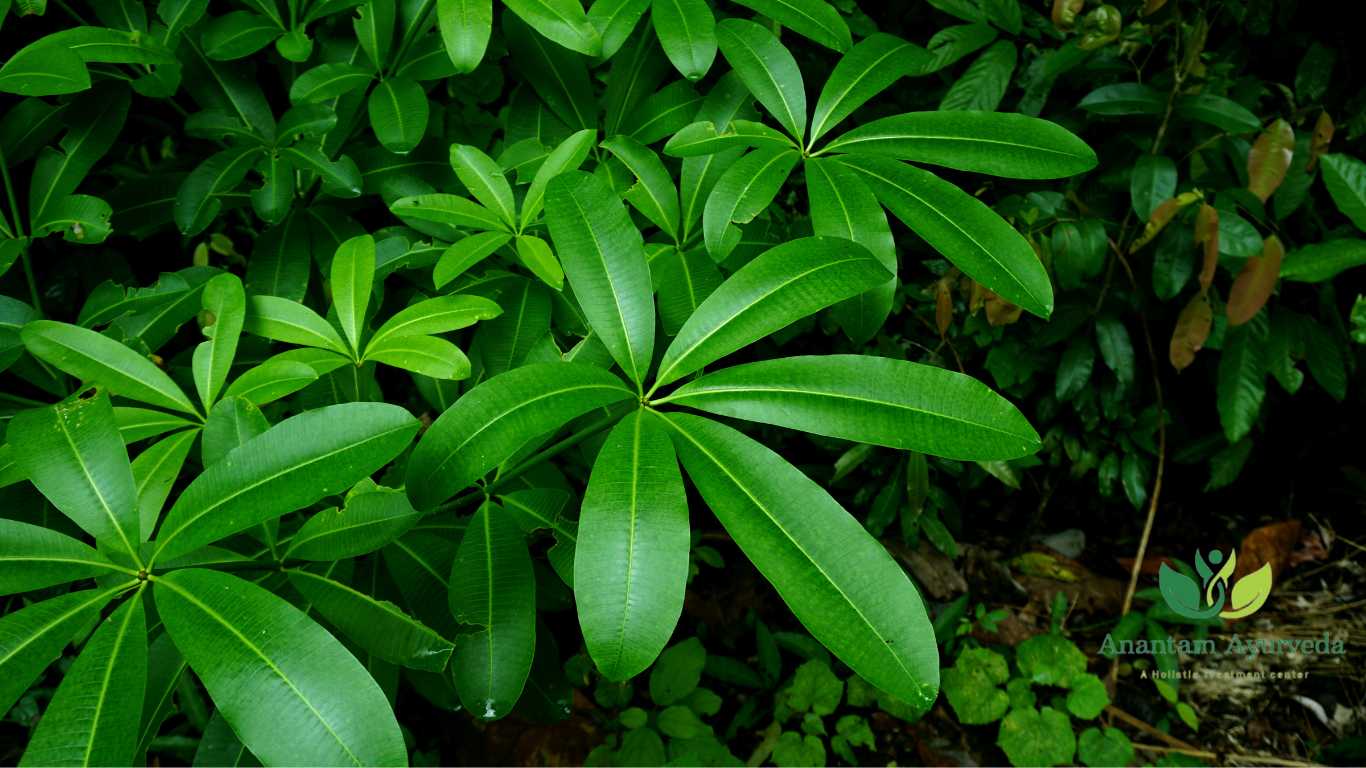
What is Saptaparni?
Saptaparni, scientifically known as Alstonia scholaris, is a versatile tree native to the Indian subcontinent and Southeast Asia. It belongs to the Apocynaceae family and stands tall as a symbol of traditional wisdom in Ayurveda. This tree has diverse uses in herbal medicine, with its bark, leaves, and seeds containing valuable compounds. Saptaparni plays a pivotal role in respiratory health, digestive wellness, and skin care, making it a prized ingredient in Ayurvedic formulations. However, it’s essential to approach its usage with guidance from Ayurvedic practitioners to harness its benefits safely and effectively.
Vernacular Names of Saptaparni (Alstonia scholaris)
Saptaparni is known by various names across different languages and regions:
-
Hindi: Satouna, Chitvan, Chitavan
-
Telugu: Edakula Ponna, Edakulariti
-
English: Dita, Milkwood Pine, White Cheesewood, Blackboard Tree, Indian Devil Tree
-
Bengali: Chatim
-
Punjabi: Satouna
-
Marathi: Satvina, Satveena
-
Gujarati: Satvana, Saatavan
-
Kannada: Maddale
-
Tamil & Malayalam: Pala
Sanskrit Synonyms of Saptaparni
-
Vishala, Vishalatwak – Named for its widely spread bark, which is the primary medicinal part.
-
Visamacchada – Refers to its rough and uneven bark texture.
-
Sharada – Named because it blooms during the autumn season (Sharat Ritu).
-
Salmali Patraka – The leaves resemble those of the Shalmali tree (Bombax malabaricum).
-
Saptacchada – Indicates that the bark is a widely used medicinal part.
-
Suparnaka – Named for its beautifully arranged leaf clusters.
These names reflect the plant’s distinct morphology, seasonal characteristics, and medicinal applications in Ayurveda.

Classical Categorization
Saptaparni has been classified into various therapeutic groups in Ayurvedic scriptures:
-
Charaka Samhita:
-
Kusthaghna – A group of herbs beneficial for treating skin ailments.
-
Udarda Prashamana – Used to manage allergic skin conditions and fungal infections like ringworm.
-
Kashaya Skandha – Recognized for its astringent taste and healing properties.
-
Tikta Skandha – Categorized among the group of bitter-tasting herbs known for detoxification.
-
-
Sushruta Samhita: Placed under the Aragvadhadi and Lakshadi groups, which include herbs beneficial for skin and blood purification.
-
Vagbhata: Also classified in the Aragvadhadi group of medicinal plants.
Varieties
A similar species, Alstonia macrosperma, is often used as an alternative due to its comparable medicinal properties.
Natural Habitat & Distribution
Saptaparni thrives in:
-
India: Found in the Sub-Himalayan region, West Bengal, Bihar, Peninsular India, and the Andaman Islands.
-
Karnataka: Particularly prevalent in drier regions such as the Shimoga district.
Morphology of Saptaparni (Alstonia scholaris)
Saptaparni is a tall, evergreen tree recognized for its distinctive milky latex, which has a characteristic bitter taste and medicinal value.
-
Bark: The bark is grey, rough, and textured, with whorled branching that gives the tree a unique appearance.
-
Leaves: Arranged in whorls of 4 to 7, the leaves have a dark green upper surface and a pale underside. They are oblong-lanceolate in shape, with a tapering base and an obtuse tip.
-
Inflorescence: The flowers are arranged in cyme-like clusters, contributing to the tree’s aesthetic and medicinal significance.
-
Flowers: Small, greenish-white blossoms with a mild fragrance, commonly seen during the flowering season.
-
Fruits: The tree produces cylindrical, pendulous follicles that grow in clusters.
-
Seeds: Each seed is flattened and equipped with fine hairs at both ends, with the hairs being longer than the seed, aiding in wind dispersal.
Saptaparni’s distinct physical features, from its whorled leaves to its fragrant flowers and medicinal latex, make it an invaluable tree in Ayurveda and traditional medicine.
The Chemical Composition and Useful Parts of Saptaparni
The Saptaparni tree is a treasure trove of valuable compounds. Its bark, leaves, and seeds have medicinal properties. The chemical composition of Saptaparni includes alkaloids, flavonoids, glycosides, and tannins, which contribute to its therapeutic effects.
- Bark: The bark of Saptaparni is rich in alkaloids, particularly echitamine and echitenin. These compounds have shown anti-inflammatory and analgesic properties.
- Leaves: Saptaparni leaves contain glycosides like echinacoside and vincoside, which are useful for their antipyretic and hepatoprotective effects.
- Seeds: The seeds of Saptaparni are a source of essential oils and fatty acids, which have potential benefits for skin and hair health.
- Ditamine, Echitenine, Echitamine – Considered natural substitutes for quinine, aiding in fever management.
- Additional Alkaloids: Akuammidine, Picrinine, Strictamine, Tetrahydroalstonine, Angustilobine B, Scholaricine, and more.
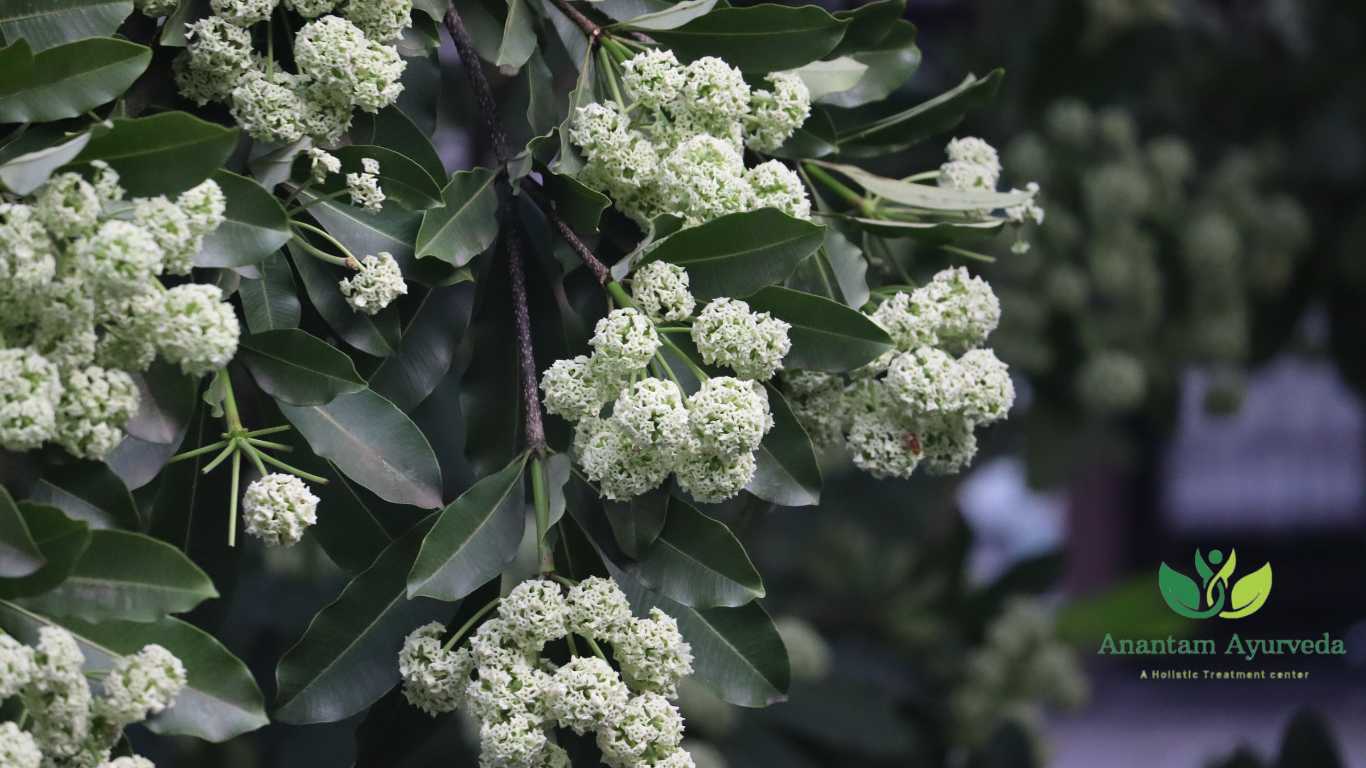
Qualities of Saptaparni According to Ayurveda
According to Ayurveda, Saptaparni exhibits a unique set of qualities or “gunas” that contribute to its remarkable healing properties:
Rasa (Taste): The primary taste of Saptaparni is bitter (tikta) and astringent (kashaya), imparting a characteristic zest to its leaves.
Guna (Quality): Saptaparni’s predominant qualities include lightness (laghu) and unctuousness (snighdha), aligning with its role as an effective herb for various ailments.
Virya (Potency): Saptaparni possesses a heating potency (ushna virya), which imparts warmth and stimulation to the body. This potency aids in regulating Vata and Kapha doshas.
Vipaka (Post-Digestive Effect): The post-digestive effect of Saptaparni is pungent (katu), contributing to its ability to balance the body’s constitution even after digestion.
Pharmacological Actions & Benefits
-
Stimulant – Revitalizes bodily functions.
-
Carminative – Aids digestion and relieves bloating.
-
Stomachic – Strengthens digestive health and improves appetite.
-
Expectorant – Helps expel phlegm, making it beneficial for respiratory conditions.
-
Febrifuge – Effective in reducing fever and associated symptoms.
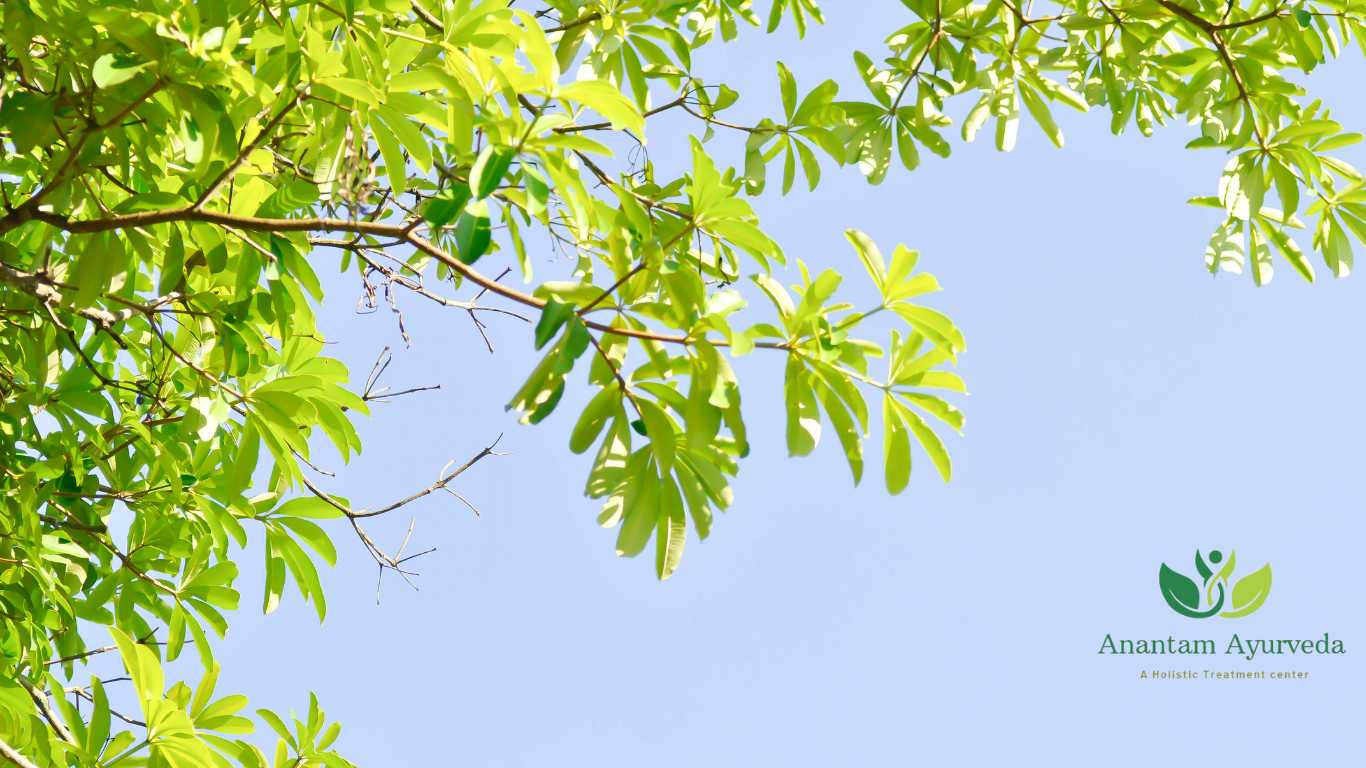
| Quality | Description |
|---|---|
| Rasa (Taste) | Bitter (tikta) and Astringent (kashaya) |
| Guna (Quality) | Lightness (laghu) and Unctuousness (snighdha) |
| Virya (Potency) | Heating (ushna virya) |
| Vipaka (Effect) | Pungent (katu) after digestion |
Saptaparni’s Influence on Doshas in Ayurveda
Saptaparni plays a crucial role in balancing all three doshas—Vata, Pitta, and Kapha. Its bitter and astringent properties help regulate excess Pitta and Kapha, while its light and slightly unctuous nature pacifies Vata.
Usage & Dosage in Ayurveda
-
Parts Used: Stem bark, latex, flowers.
-
Recommended Dosage:
-
Bark Decoction: 20–80 ml per day (divided doses, based on the ailment and individual constitution).
-
Powder (Churna): 1–1.5 g per day.
-
Saptaparni is a potent Ayurvedic herb with immense therapeutic value. However, its use should be guided by a qualified Ayurvedic practitioner to ensure safety and effectiveness.

Health Benefits of Saptaparni (Alstonia Scholaris)
Saptaparni, scientifically known as Alstonia scholaris, offers a wide range of health benefits deeply rooted in Ayurvedic tradition. Here are some of the key advantages associated with this remarkable herb:
- Respiratory Health: Saptaparni is a powerful ally in maintaining respiratory well-being. It acts as a bronchodilator, helping to ease the airways and making it particularly effective in managing respiratory conditions such as asthma, bronchitis, and cough. The anti-inflammatory properties of its alkaloids aid in reducing airway inflammation, promoting easier breathing.
- Digestive Aid: Incorporating it into your diet can enhance digestion and alleviate issues like indigestion and bloating. The bitter taste of Saptaparni stimulates digestive juices, improving overall digestive function and nutrient absorption.
- Skin and Hair Care: The seeds and leaves of Saptaparni are useful in various cosmetic products due to their potential benefits for skin and hair. They moisturize the skin, enhance its texture, and can even help prevent hair fall, making them valuable additions to natural beauty regimens.

- Immunity Booster: Regular consumption of Saptaparni can strengthen the immune system. Its antioxidant-rich compounds help the body fight off infections, bolstering overall immunity and resilience against illnesses.
- Anti-inflammatory Properties: The alkaloids present in Saptaparni exhibit potent anti-inflammatory effects. This property makes it valuable in managing conditions like arthritis and joint pain, where inflammation plays a significant role.
- Fever Relief: It has antipyretic properties, meaning it can help reduce fever. It is useful to alleviate fever symptoms and aid in a quicker recovery.
- Anti-Malarial: In some regions, Saptaparni is useful as a remedy for malaria due to its potential to combat the malarial parasite.
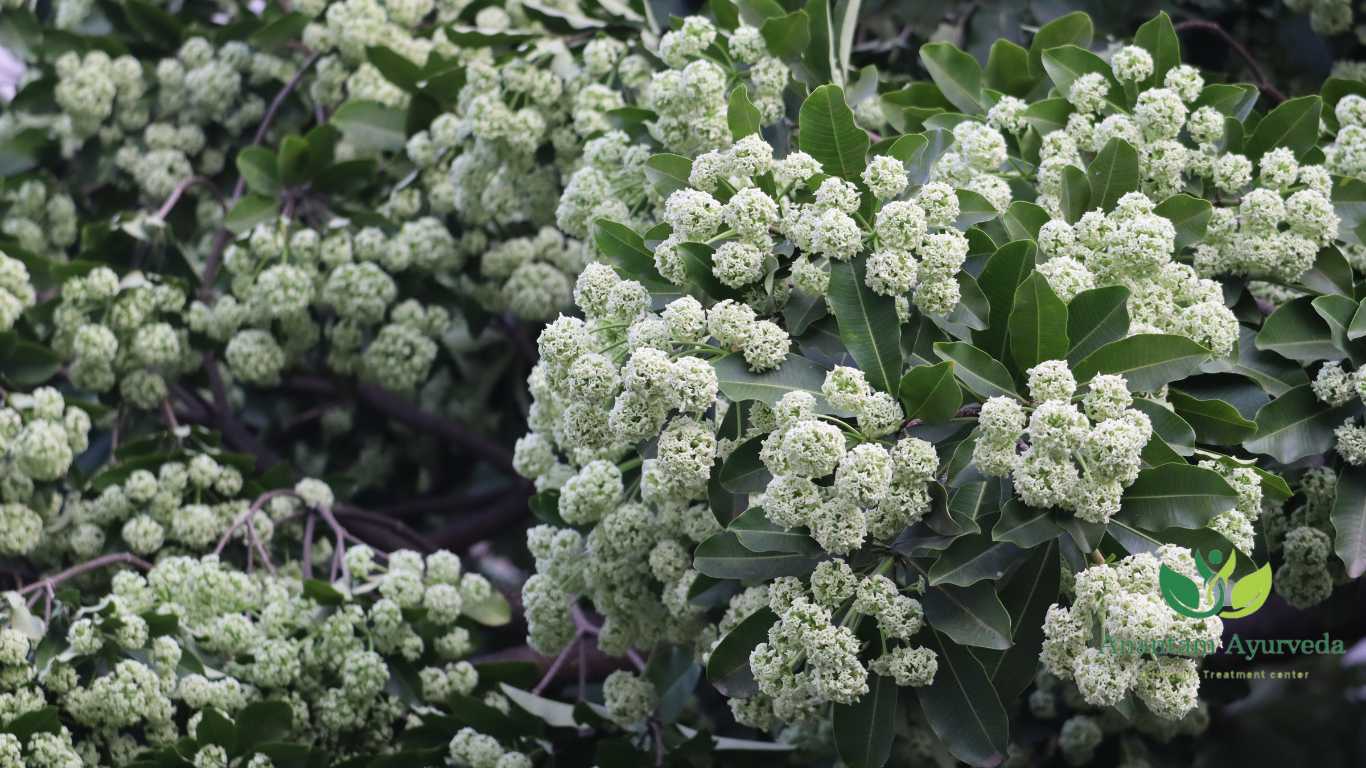
How to Use Saptaparni (Alstonia Scholaris)
Saptaparni (Alstonia scholaris) is a versatile herb in Ayurveda, and it can be incorporated into your wellness routine in various forms. Here are some common methods of using it:
1. Herbal Infusion:
One of the simplest ways to benefit from Saptaparni is by preparing an herbal infusion or tea. Follow these steps:
-
- Boil a few Saptaparni leaves or a small piece of bark in water.
- Let it simmer for about 5-10 minutes.
- Strain the infusion and allow it to cool.
- Drink this herbal tea. It can help with respiratory issues, digestive discomfort, and overall well-being.
2. Ayurvedic Formulations:
Saptaparni is often a key ingredient in various Ayurvedic formulations such as churnas (powders), tablets, and oils. These formulations are useful for specific health concerns and are typically available through Ayurvedic practitioners or herbal stores. Consult an Ayurvedic expert or healthcare professional to determine the right formulation for your needs.
3. Saptaparni Oil:
Saptaparni oil is used topically for massages, especially in Ayurvedic practices like Abhyanga. It can help alleviate joint pain, improve skin health, and promote relaxation. Massage the oil gently onto the affected areas or use it for a full-body massage.
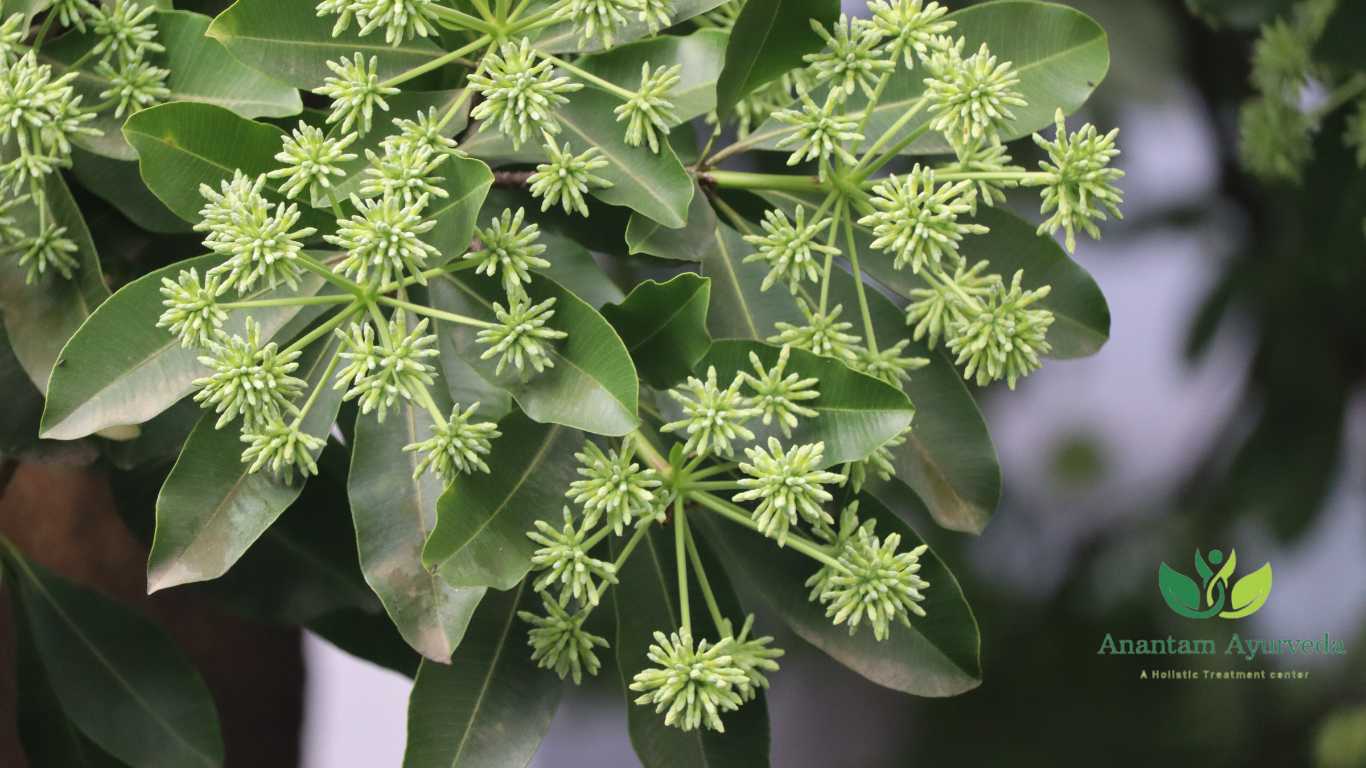
4. Saptaparni Powder:
Saptaparni bark can be ground into a fine powder. This powder can be used in various ways, such as:
-
- Oral Consumption: Mix a small quantity of powder with honey or warm water and consume it to aid digestion or address respiratory issues.
- Topical Application: Create a paste by mixing powder with water and apply it to the skin to address skin conditions.
5. Consult an Ayurvedic Practitioner:
It’s important to note that it should be used under the guidance of an Ayurvedic practitioner or healthcare professional. They can provide personalized recommendations, dosage instructions, and ensure that its usage aligns with your specific constitution and health needs.
6. Safety Precautions:
While it offers numerous health benefits, it’s crucial to exercise caution and adhere to safety guidelines:
-
- Always consult a healthcare professional or Ayurvedic expert before starting any new herbal regimen, especially if you have underlying medical conditions or are taking medications.
- Pregnant and nursing women should avoid it due to its potential effects on uterine contractions.
- Individuals with a Pitta constitution should consume it in moderation, as it may increase Pitta dosha.
Incorporating it into your daily routine can be a valuable step towards harnessing the benefits of this Ayurvedic herb. However, always seek expert guidance to ensure safe and effective usage based on your unique health profile.

Why Saptaparni Is Called Devil’s Tree?
The key reason behind this ominous nickname lies in the milky white sap produced by Saptaparni. This sap, while visually innocuous, contains alkaloids that are toxic and harmful to humans and animals. It’s this toxic sap that earned the tree its sinister title.
The toxicity of Saptaparni’s sap serves as a natural deterrent against herbivores and insects, helping the tree defend itself against potential threats. In the context of its ecosystem, this defense mechanism is indeed effective.
However, it’s essential to emphasize that while the sap is toxic, the rest of the tree, including its leaves, bark, and seeds, possesses valuable medicinal properties and is useful extensively in traditional systems of medicine like Ayurveda.
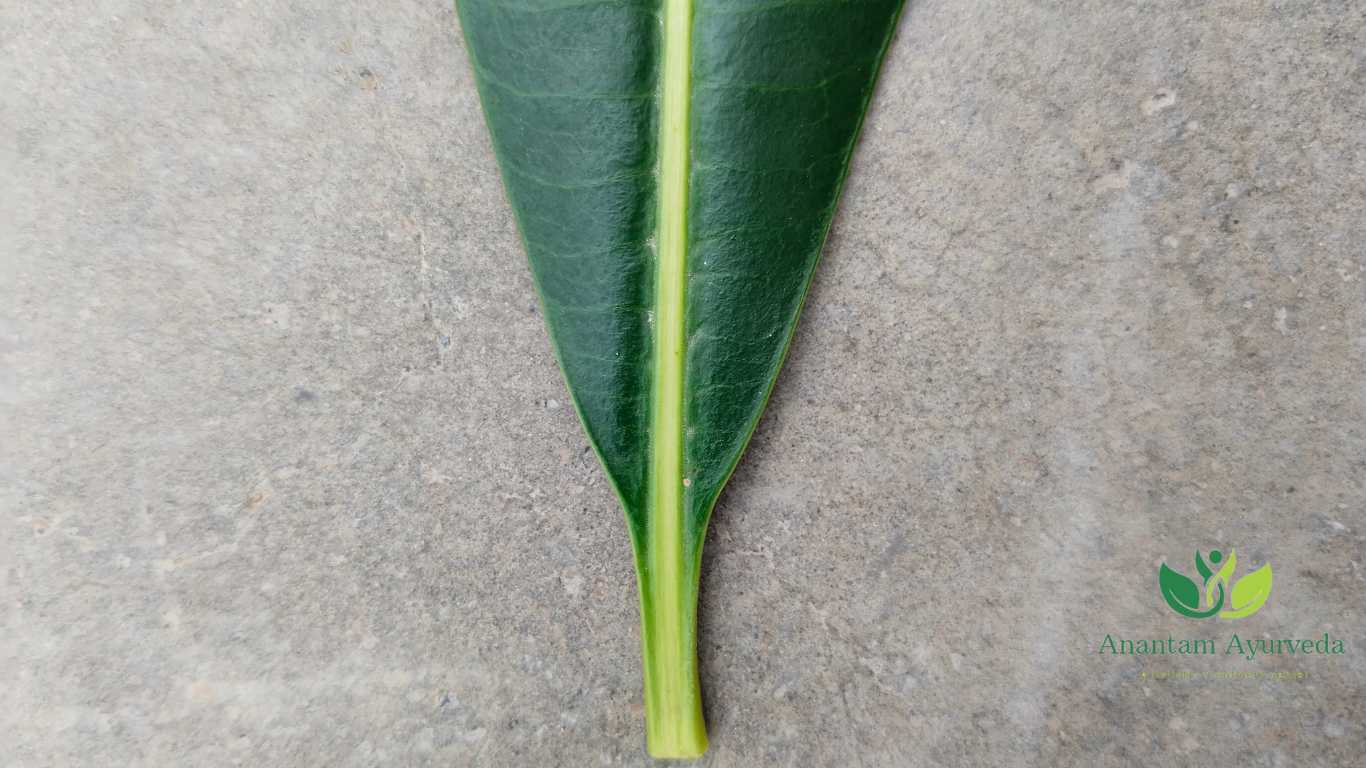
In conclusion, Saptaparni, or Alstonia scholaris, is a botanical marvel with a rich history in traditional medicine. Its diverse range of applications, from respiratory health to skincare, makes it a valuable addition to your wellness regimen. However, always seek guidance from a healthcare professional or Ayurvedic expert before incorporating it into your daily routine.
Frequently Asked Questions about Saptaparni
1. What is Saptaparni?
Saptaparni (also known as Alstonia scholaris) is a tall evergreen tree native to the Indian subcontinent and Southeast Asia. People value it for its ecological and medicinal uses.
2. What are the uses of Saptaparni?
People use various parts of the tree, such as the bark, leaves, and roots, in traditional medicine. It:
-
Acts as a cardiac tonic
-
Purifies the blood
-
Aids digestion
-
Treats intestinal worms
-
Promotes wound healing
-
Helps with asthma and boosts lactation
3. What are the chemical constituents of Saptaparni?
The tree contains alkaloids like echitenine, ditamine, and echitamine, which provide medicinal benefits similar to quinine.
4. What is the significance of Saptaparni in urban forestry?
People plant Saptaparni in urban areas for its shade and its ability to reduce pollution.
You can also read about Dengue.
You can follow us on twitter, facebook, & Google News
